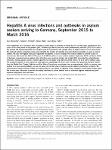Hepatitis A virus infections and outbreaks in asylum seekers arriving to Germany, September 2015 to March 2016
Michaelis, Kai
Wenzel, Jürgen J.
Stark, Klaus
Faber, Mirko
From September 2015 to March 2016, hepatitis A notifications in Germany increased by 45% to 699 cases compared to 482 cases in the same period of the previous year. Children aged five to nine years were predominantly affected (22% of all cases in this period). We hypothesized that this increase could be explained by the marked influx of asylum seekers in this time period. We analysed national surveillance data and estimated the number of imported and autochthonous hepatitis A cases in asylum seekers. We also investigated molecular signatures of hepatitis A viruses sampled from asylum seekers to identify chains of transmission. We found that 40% (278 cases) of all 699 hepatitis A cases notified between September 2015 and March 2016 in Germany concerned asylum seekers. Most infections were acquired abroad, but at least 24% accounted for autochthonous infections. Among asylum seekers, children aged five to nine years were overrepresented with 97 of 278 (35%) notified cases. The analysed hepatitis A virus sequences were primarily subgenotype IB strains and clustered with previously isolated samples from the Middle East, Turkey, Pakistan and East Africa. Except one transmission from an asymptomatic child to a nursery nurse working in a mass accommodation, we are not aware of infection chains involving asylum seekers and German residents. We conclude that asylum-seeking children and adolescents are susceptible to hepatitis A virus infections, particularly children aged five to nine years. Measures to prevent secondary infections in asylum seekers such as extended hygiene measures and post-exposure prophylaxis seem advisable.
Dateien zu dieser Publikation
Keine Lizenzangabe

